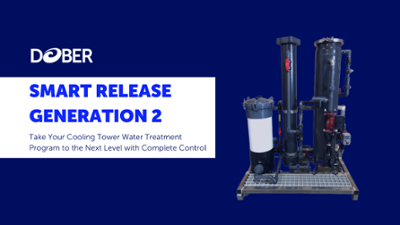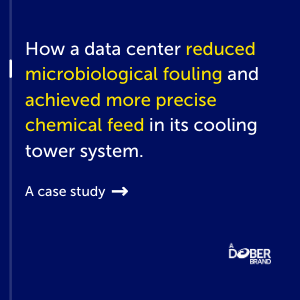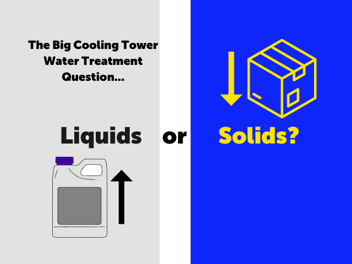How Cooling Tower Water Treatment Touches So Many Aspects of our Lives
What does a cooling tower do? Where do you find them? Why are they important? What does a cooling tower water treatment program entail?
If you're not in the cooling tower industry, you might have asked yourself one of those questions. You might have even asked yourself: what does a cooling tower look like? Maybe you've even seen a cooling tower while out driving and not even known it.
That might be especially true if you're an executive at a school system, hospital, data center or another large site and you have to determine how to allocate funds toward various facility upgrades.
Bottom line, even if you're not the property manager — say you're a school superintendent or a hospital CEO — you still want to have a working knowledge of what a cooling tower does for your site, not to mention the potential hidden costs that can come from poor or inconsistent cooling tower water treatment and maintenance.
Well, never fear. No matter your professional experience or knowledge level, in this article we will summarize what a cooling tower is, what it does and why it is an important part of any large operation.
As always, never hesitate to reach out to our team if you have any questions about Smart Release Technology at your site.
Cooling Tower Water Treatment Impacts
In fact, it's safe to say cooling towers touch just about every aspect of our lives, from education to food to health care — and much, much more.
If you're new to the subject area, sometimes the easiest way to digest information about a brand-new subject is by breaking it down by the five Ws: who, what, where, when and why.
By the end of this article, you should have a better understanding of:
- What a cooling tower is used for
- Where you'll typically find them
- And why you need them (not to mention what happens if you don't properly maintain one)

Who uses cooling towers and/or manages them?
Property managers and their team of trained engineers are tasked with managing the cooling tower system. A wide variety of industry segments benefit from cooling tower systems, including school districts, data centers, manufacturing operations, hospitals, power plants and many others. .png?width=400&height=300&name=SRT-Cooling-Tower-Uses%20(1).png)
Long story short, even if you don't know much about cooling towers or cooling tower water treatment, you probably benefit from them, whether at your job or another important place you may visit.
Cooling tower water treatment systems impact all aspects of our lives, from the building in which our children learn, the facilities in which people receive critical health care and the places where power is generated that allows us to live our 21st century lives.
What do cooling towers do?
In a nutshell, cooling towers transfer heat safely from inside an active system to the outside environment, which you'll often see in the form of a billowing mist (like the image above).
Put it this way: different species have different ways of achieving their cooling needs. Dogs, for example, cool down by panting. Humans cool down through the process of perspiration.
In a sense, that is what a cooling tower is doing: perspiring and expelling excess heat out of a system. In this case, rather than the human body, substitute for a hospital or data center, for example.
Induced-draft cooling towers come in two different forms: counterflow and crossflow. Counterflow cooling tower systems entail air crossing moving in the opposite direction of the process water. Meanwhile, in a crossflow system, air travels horizontally with the direction of the water.
Hot water is pumped into the cooling tower from the industrial system for cooling. The hot water moves and spreads out onto the cooling tower "fill" surface. Air is blown into the cooling tower, which contacts the water and carries excess heat out of the cooling tower via evaporation. The resulting cooled water is collected in the cooling tower basin and recycled for reuse in the system.
Cooling towers use water because of its robust heat-transfer capabilities to transfer excess heat out of a system, often through evaporation. Without that heat-transfer capacity, your system will continue to produce heat without rejecting it safely into the external atmosphere.
However, the process isn't just about water and water alone.
Over time, you need an effective cooling tower water treatment program to ensure those towers continue to work properly and transfer heat effectively.
Where do you typically see cooling towers?
Cooling towers can be found at a wide range of site types. Below is a list of some places you might see a cooling tower:
- Manufacturing facilities
- Hospitals
- Schools
- Data centers
- Office buildings
Any location requiring significant cooling will need cooling towers and cooling tower water treatment programs designed to manage the transfer of heat out of the system. In short, you can see how cooling towers and cooling tower water treatment programs are intertwined with many critical aspects of our lives.
When did cooling towers begin to be used?
Cooling towers have been around for over a century.
Dutch engineers Gerard Kuypers and Frederik van Iterson developed the first hyperboloid cooling tower in the early 1900s. Kuypers filed a patent in 1917 for a "cooling tower of reinforced concrete."
So, cooling towers have been around for quite a while, underscoring how critical they are, particularly with respect to support of the advancement of the Industrial Revolution of the 18th and 19th centuries.
Why is an effective cooling tower water treatment program necessary?
We've talked about cooling towers, generally, but why do you need robust and consistent management of your cooling tower water treatment program?
As water circulates and is recycled in the cooling tower system, a number of things can happen that ultimately mitigate the system's efficacy.
Corrosion and scale
Corrosion, scale and microbial growth can all cause the cooling tower's heat-transfer capacity to decline. Scaling can often occur within the system as a result of water hardness.
As water circulates through the system, ions can be picked up that then cause corrosion and scale of materials in the tower (thereby mitigating those surfaces' heat-transfer capacity). In turn, that means a less effective and less efficient system.
As such, it's important to have a program of corrosion and scale inhibitors to mitigate these effects.
Microbial growth
Meanwhile, cooling towers provide a welcoming environment (i.e., warm and wet) for microbial growth. As such, if left untreated or treated ineffectively, microbial growth can reduce heat-transfer capacity and even damage material components in the system. Even worse, bacteria like legionella can spread via the droplets expelled from the cooling tower system; when inhaled, these droplets can lead to Legionnaires' disease, a form of pneumonia.
As such, every good cooling tower water treatment program includes a regimen of biocides to mitigate microbial growth.
Furthermore, the delivery of these important cooling tower water treatment chemicals can vary. Cooling tower water treatment programs can use liquid chemicals or solids (e.g., coated tablets).
---
Want to learn more about cooling tower water treatment solutions? As noted above, there are cooling tower water treatment programs based on liquid chemicals, while others utilize solid chemistries.
Smart Release Technology uses solid chemistries to deliver chemicals into the cooling tower system, providing corrosion and scale protection and mitigating microbial growth with biocides like Smart Release™ Bio-Clear (DBNPA).
Click below to download your copy of the Smart Release Generation 2 e-book to learn more about our solid-based technology.






